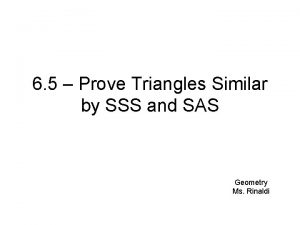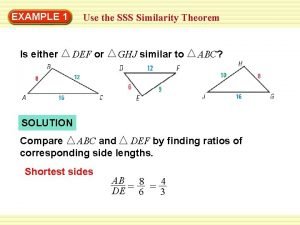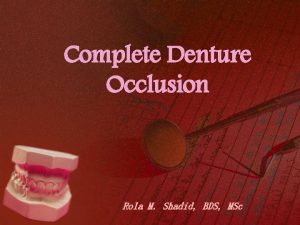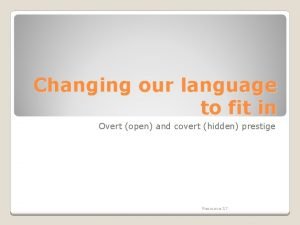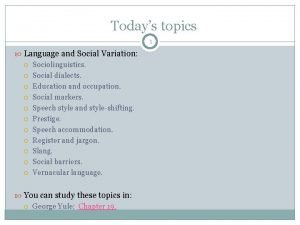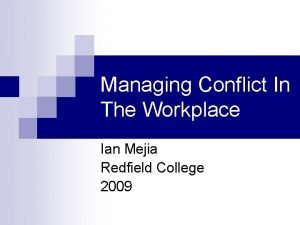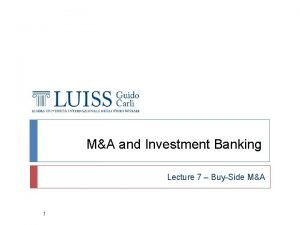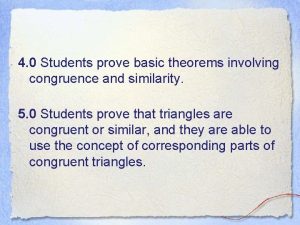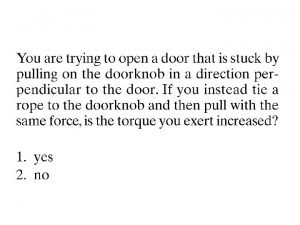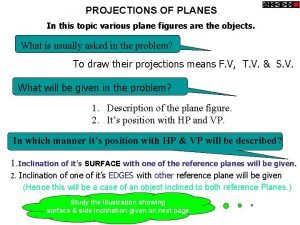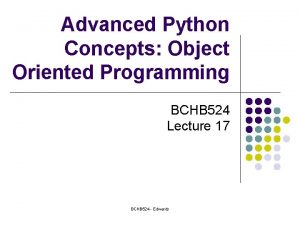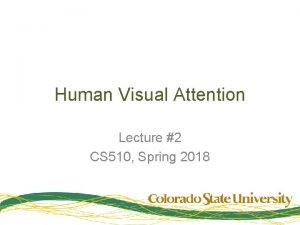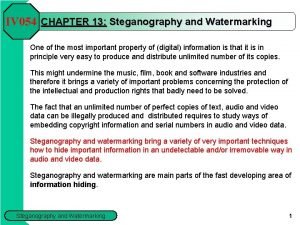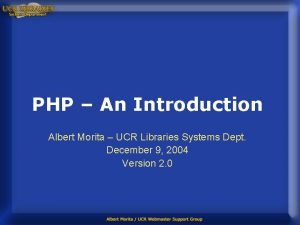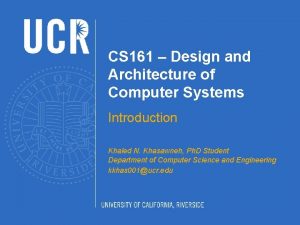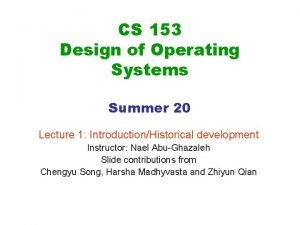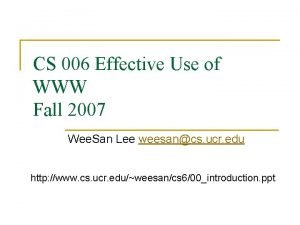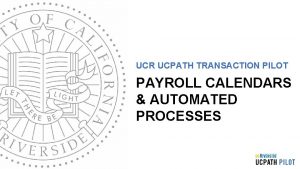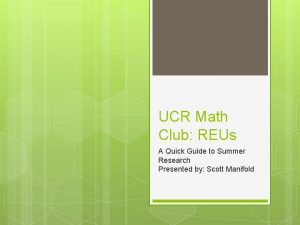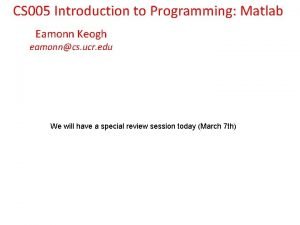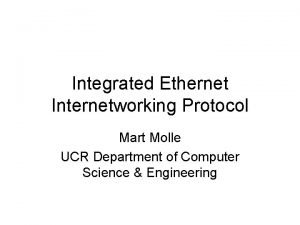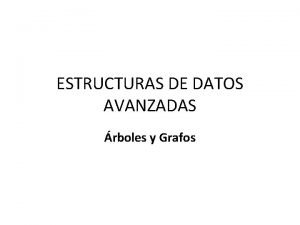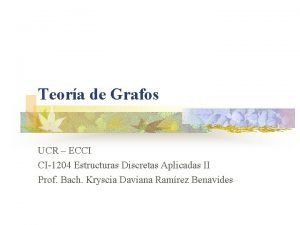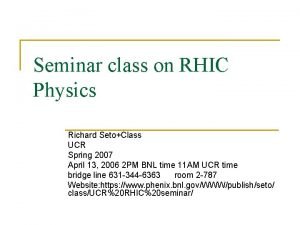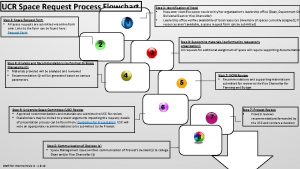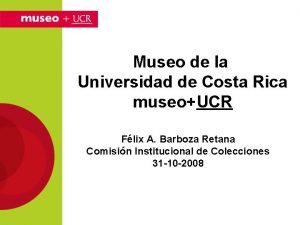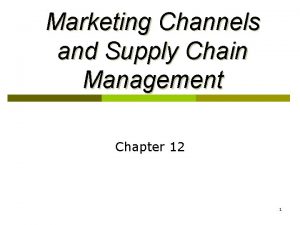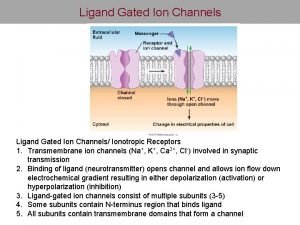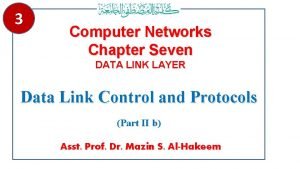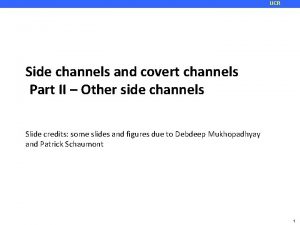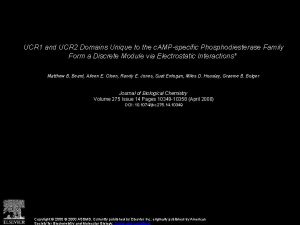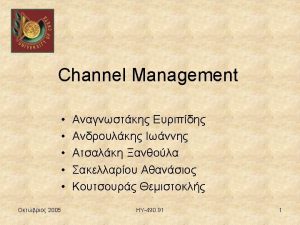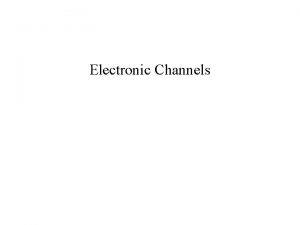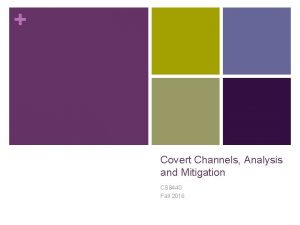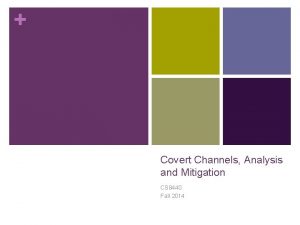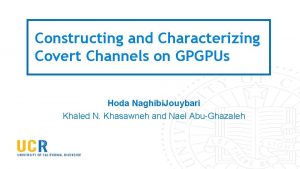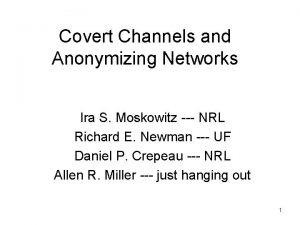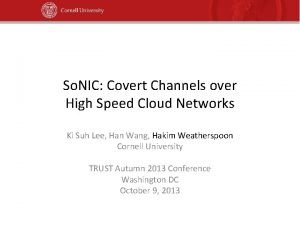UCR Side channels and covert channels Part I










![UCR Cache missing for fun and profit [Percival] Paper introduces: Access driven attacks Spy UCR Cache missing for fun and profit [Percival] Paper introduces: Access driven attacks Spy](https://slidetodoc.com/presentation_image/2a35b619d3658b8779c9309508246202/image-11.jpg)

















































































- Slides: 92

UCR Side channels and covert channels Part I – Architecture side channels Slide credits: some slides and figures adapted from David Brumley, AC Chen, and others 1

UCR Traditional Cryptography COMMUNICATION CHANNEL Policy Alice • Confidentiality • Integrity • Authenticity Bob Interception (Threat) Confidentiality (Policy) Encryption (Mechanism) Modification (Threat) Integrity (Policy) Hash (Mechanism) Fabrication (Threat) Authenticity (Policy) MAC (Mechanism) Security Attacks Mallory 2

UCR Threat Model Message E Communication Channel Ka Alice D Message Kb leaked Information Bob Side Channels in the real world Through which a cryptographic module leaks Assumptions Mallory information to its environment unintentionally - Only Alice Knows Ka - Only Bob Knows Kb - Mallory has access to E, D and the Communication Channel but does not know the decryption key Kb 3

UCR Side Channel Sources Threat Model & Security Goal Traditionally we have Cryptographic Algorithms handled only Protocols Software Human User • Key dependent Variations computation time Hardware E/D K Real World System • Power consumption • EM Radiations Deployment & Usage 4

UCR Power Analysis Attack Idea: During switching CMOS gates draw spiked current Trace of Current drawn - RSA Secret Key Computation Only Squaring and multiplication Reported Results : Every Smartcard in the market BROKEN 5

UCR 6

UCR Covert channel vs. Side channel • Covert channel players: Trojan and spy • Trojan communicates with the spy covertly using the covert channel • Example: two prisoners communicating by banging on pipes • Side channel players: victim and spy • Spy attempting to figure out what victim is doing by observing side channel • Example: My students determining if I am here based on smell of coffee around my office • Key property: cooperation • Are covert channels a security concern? 7

UCR How dangerous is the problem? • What makes a channel a side channel? • Intended by the primary designer of the system or not • One check: an implementation artifact • Many side channels require physical access • The spy has to be able to measure • Today: Architecture based side channels • Victim and spy run on the same system • Spy uses the shared architecture components as a side channel 8

UCR Microarchitecture side channels • Modern processors support multiple programs running at the same time • Even that is not necessary for many attacks; multiprogramming is enough • Side channels galore!! • What one process does can affect others • Denial of service also possible • What are examples? 9

UCR Simple attack—timing based attack ¢ ¢ Assumption: we can observe the time a crypto operation takes (maybe time until a packet is sent) There are variations in the time of encryption based on the key (for the same data) By measuring the time, parts of the most likely keys are identified See paper by Bernstein for complete description of the attack ¢ Powerful attack However, requires known plaintext attack Requires access to the server to do the timing and build a key database 10
![UCR Cache missing for fun and profit Percival Paper introduces Access driven attacks Spy UCR Cache missing for fun and profit [Percival] Paper introduces: Access driven attacks Spy](https://slidetodoc.com/presentation_image/2a35b619d3658b8779c9309508246202/image-11.jpg)
UCR Cache missing for fun and profit [Percival] Paper introduces: Access driven attacks Spy actively accesses the cache to make the side channel possible 11

UCR Caching is a source of covert channels ¢ ¢ Two processes sharing a memory mapped file Trojan: accesses a page of the file if it wants to communicate 1 Page brought into memory ¢ Spy accesses the same page and times the access Fast trojan accessed it! 1 Slow No access – 0! ¢ ¢ ¢ Have to work out some timing issues Noise could be a problem Works even if a single core 12

UCR What if they do not share a file/memory? ¢ ¢ ¢ Can still communicate! Focus on removing something rather than bringing it in Here’s a scenario Trojan fills “cache” with its own pages (prime phase) Victim accesses different part of memory in a certain pattern Cache is limited in size, this replaces some of the trojan’s pages in the shared cache Trojan when it re-accesses its pages, experiences misses. Pattern can be used to communicate ¢ ¢ Attach where memory is shared called flush-and-reload attack This variant called prime-and-probe 13

UCR Common attack L 1 side channel ¢ Good for attack: L 1 caches are fast and small; can probe them quickly They often are virtually indexed ¢ Physically indexed caches are more challenging because you don’t know your physical address Bad for attack: L 1 caches are private Attack is SMT/hyper-threading or core affinity based Harder to get the spy placed on the same core as the process 14

UCR LLC side channels beginning to be explored ¢ The problem is more difficult ¢ LLC are larger and slower – harder to probe More noise because they are shared among all cores Index hashing Physically indexed But more dangerous Allows cross-vm attacks on clouds. Have to be on the same machine rather than the same core ¢ ¢ Demonstrated under some conditions, but not in general Plug: we have a grant from NSF to explore this attack Let me know if you are interested in participating! 15

UCR How dangerous is this problem? • Multicore and SMT processors share at least some levels of cache hierarchy • Cache sharing opens the door for two types of attacks – Side-Channel Attacks – Denial-of-Service Attacks • We consider software cache-based side channel attacks 16

UCR Background: Set-Associative Caches 8 -way set-associative cache way 0 way 7 • In SMT/CMP processors, caches are shared • A miss by any thread can store a line in any way • Cache lines 64 -bytes; we don’t know which byte 17

UCR Shared Data Caches in SMT Processors Instruction Cache Fetch Unit Decode PC PC Issue Queue Load/Store Queues Register File PC LDST Units PC PC PC Execution Units Data Cache Register Rename Re-order Buffers Arch State Private Resources Shared Resources 18

UCR Advanced Encryption Standard (AES) • One of the most popular algorithms in symmetric key cryptography 16 -byte input (plaintext) 16 -byte output (ciphertext) 16 -byte secret key (for standard 128 -bit encryption) several rounds of 16 XOR operations and 16 table lookups secret key byte Lookup Table index Input byte 19

UCR Example of Access-Driven Attack (only attack on set 0 is shown) Cache is shared between attacker (A) and victim (V) A hit A hit AV A A A Miss! Victim’s access to set 0 determined! 20

UCR Access-Driven Attack: Example. . . A A A A A Hit Hit Hit. . . 21

UCR Access-Driven Attack: Example . . . A A A A A Victim (crypto) access . . . 22

UCR Access-Driven Attack: Example. . . A A A A Hit A A (V evicted) A A Miss! A A A A . . . 23

UCR Simple Attack Code Example #define ASSOC 8 #define NSETS 128 #define LINESIZE 32 #define ARRAYSIZE (ASSOC*NSETS*LINESIZE/sizeof(int)) static int the_array[ARRAYSIZE] int fine_grain_timer(); //implemented as inline assembler void time_cache() { register int i, time, x; for(i = 0; i < ARRAYSIZE; i++) { time = fine_grain_timer(); x = the_array[i]; time = fine_grain_timer() - time; the_array[i] = time; } } 24

UCR What are possible solutions? ¢ To side channels in general, or to this particular one? ¢ Should this problem be solved in software? …and how? ¢ AES-NI: hardware supported instructions for AES encryption No table lookup! 25

UCR Examples of Existing Solutions • Avoiding using pre-computed tables – too slow • Locking critical data in the cache (Wang and Lee, ISCA 07) • Impacts performance • Requires OS/ISA support for identifying critical data • Randomizing the victim selection ( Wang and Lee, ISCA 07) • Significant cache re-engineering • High complexity • Requires OS/ISA support to limit the extent to critical data only • Dynamic Memory-to-Cache Remapping (Wang and Lee, 2008) • Complex hardware • Significant cache redesign of peripheral circuitry 26

UCR New Cache Designs for Thwarting Software Cache-based Side Channel Attacks Zhenghong Wang and Ruby Lee 27

UCR Proposed Models ¢ ¢ ¢ The main problem is direct or indirect cache interference One of the solutions is learning from the attacks and rewrite the software Pervious solutions are attack specific and have performance degradation This paper tried to eliminate the root of the problem with minimum impact and low cost Proposed two solutions Partitioning Randomization 28

UCR Proposed Models ¢ Partition-Locked Cache (PLCache) L ID Original Cache Line 29

UCR Proposed Models ¢ Random Permutation Cache (RPCache) Introducing randomization to the memory-to-cache mapping, which eliminate knowing which cache lines evicted 30

UCR Proposed Models 31

UCR Proposed Models Cache LPCache Victim Access Attacker discovered miss Filled by attacker data RPCache Locked cache lines Replaced cache line 32

UCR Evaluation ¢ Performance impact on the protected code Open. SSL 0. 9. 7 a implementation of AES was tested on a processor with traditional cache, L 1 PLcache, and L 1 RPcache 5 Kbytes of the data needed to be protected L 2 cache is large enough, so there are no performance impact 33

UCR Evaluation ¢ Performance impact on the whole system due to the protected code AES runs with another thread simultaneously (SPEC 2000 fp and SPEC 2000 int) 34

Conclusions Cache-based side channel attacks can impact a large spectrum of systems and users Software solutions adds significant overhead Hardware solution are general purpose PLCache: Minimal hardware cost. However, developers much use there APIs RPCache: Adds area and complexity to the hardware, but the developer has to do nothing

Non Monopolizable caches Idea: prevent attacker from monopolizing the cache

UCR Desired Features and No. Mo • Desired Solution Features: • • • Hardware-only (no OS, ISA or language support) Low performance impact Low complexity Strong security guarantee Ability to simultaneously protect against denial-of-service (a by-product of access-driven attack) • Non-Monopolizable (No. Mo) Caches • Some cache ways are reserved for co-scheduled applications, others are shared • Does not eliminate all leakage, but reduces it dramatically 37

UCR No. Mo Caches 8 -way set-associative cache with No. Mo-2 T 1 T 1 Shared Ways (leakage surface) T 2 T 2 • T 1 – ways reserved for Thread 1 • T 2 – ways reserved for Thread 2 No. Mo Degree - # of ways reserved for each thread Information only leaks from shared ways 38

UCR Dynamic Mode Adjustment No restrictions when cache is not actively shared Timeout counter to detect when to exit No. Mo mode Counter keeps track of the number of consecutive cycles with no cache accesses from other applications No. Mo mode is entered when a new program starts Invalidate lines in Y ways and reserve them No. Mo mode is turned off when counter reaches threshold Invalidate and un-reserve Entry + exit = equivalent to always-on No. Mo 39

UCR Dynamic Mode Adjustment New thread enters: invalidate reserved ways, switch to No. Mo off No. Mo on Inactivity counter saturates (one of the threads is inactive) 40

UCR No. Mo Operation Example Initial No. Mo Entry Reserved Shared More Thread (Yellow cache way 2 enters =usage T 1, usage Blue = T 2) F: 1 H: 1 R: 2 C: 1 Q: 2 K: 1 A: 1 P: 1 G: 1 B: 1 N: 1 J: 1 N: 1 D: 1 M: 1 L: 1 T: 2 S: 2 I: 1 U: 2 O: 1 E: 1 • Showing 4 lines of an 8 -way cache with No. Mo-2 • X: N means data X from thread N 41

UCR Why Does No. Mo Work? • Victim’s accesses become visible to attacker only if the victim has accesses outside of its allocated partition between two cache fills by the attacker. • In this example: No. Mo-1 42

UCR Evaluation Methodology • Used Pin-based x 86 trace-driven simulator with Pintools • Evaluated security for AES and Blowfish encryption/decryption • Ran security benchmarks for 3 M blocks of randomly generated input • Implemented the attacker as a separate thread and ran it alongside the crypto processes • Assumed that the attacker is able to synchronize at the block encryption boundaries (i. e. It fills the cache after each block encryption and checks the cache after the encryption) • Evaluated performance on a set of SPEC 2006 Benchmarks. 43

UCR Metrics for Evaluating Security • Exposure Rate: percentage of cache accesses by the victim that are visible through the side channel • Critical Exposure Rate: percentage of CRITICAL accesses by the victim that are visible through the side channel • Critical accesses are the accesses to precomputed AES tables 44

UCR Aggregate Exposure of Critical Data 45

UCR Aggregate Exposure of All Data 46

UCR Worst-Case (per block) Exposure of Critical Data 47

UCR Worst Case (per block) Exposure of All Data 48

UCR Impact on IPC Throughput (105 2 -threaded SPEC 2006 workloads simulated) 49

UCR Impact on Fair Throughput (105 2 -threaded SPEC 2006 workloads simulated) 50

UCR No. Mo Design Summary • Practical and low-overhead hardware-only design for defeating access-driven cache-based side channel attacks • Can easily adjust security-performance trade-offs by manipulating degree of No. Mo • Can support unrestricted cache usage in single-threaded mode • Performance impact is very low in all cases • No OS or ISA support required 51

UCR A High-Resolution Side-Channel Attack on Last-Level Cache Mehmet Kayaalp, IBM Research Nael Abu-Ghazaleh, University of California Riverside Dmitry Ponomarev, State University of New York at Binghamton Aamer Jaleel, Nvidia Research The 53 rd Design Automation Conference (DAC), Austin, TX, June 8, 2016 52

UCR Cache Side-Channel 28 1 e 4 c 24 09 bf 15 82 30 6 f 53 d 9 a 4 49 2 d 0 e Sub. Bytes f 2 85 5 c 06 6 a 91 4 e 0 c c 4 fc da a 8 d 5 37 e 9 9 c S-Box Set-associative cache sets ways 53

UCR Flush+Reload Attack 2 - Victim accesses critical data CPU 1 CPU 2 Victim Attacker 1 - Flush each line in the critical data 3 - Reload critical data (measure time) L 1 -D L 1 -I L 2 Shared L 3 Cache Evicted Time set s ways 54

UCR Prime+Probe: L 1 Attack 2 -way SMT core 1 - Prime each cache set 2 - Victim accesses critical data Victim Attacker L 1 -I 3 - Probe each cache set (measure time) L 1 -D L 2 L 1 Cache Evicted Time sets ways 55

UCR Prime+Probe: LLC Attack 2 - Victim accesses critical data CPU 1 CPU 2 Victim Attacker 1 - Prime each cache set 3 - Probe each cache set (measure time) Back-invalidations L 1 -D L 1 -I L 2 Evict critical data Shared L 3 Inclusive Challenges: • Find collision groups for each cache set • Discover hardware details • Identify a minimal set of addresses per cache set • Find which are the critical cache sets • Find which cache sets incur the most slowdown for the victim • Among those, look for the expected access pattern 56

UCR Discovering LLC Details Intel Sandy Bridge die 4 x Cores 4 x 2 MB LLC Banks 12 63 Virtual Address virtual page number page offset 12 63 L 1 Access Physical Address tag set index 6 0 line offset 12 35 physical page number 0 page offset 17 35 LLC Access 0 tag 6 set index Hash 0 line offset bank select 57

UCR Bank Selection and Cavity Sets <H 0, H 1>: <00> <11> Number of ways: 15 cavity sets <01> <10> 16 16 17 35 6 tag ●● ● 16 ● ●●●● set index ●●●●● ● ● ● ●● ● line offset ● ● ●●●●●●● ●● ● 0 H 1 XOR 58

UCR Finding Collision Groups Memory Page same set index x N = Cache Size … number of ways N = (8 MB / 4 KB / 16) = 128 ɸ={} Add page ρ to ɸ Measure ∆t = t( ɸ ) - t( ɸ - ρ ) If ∆t is high For each ρi∈ ɸ N Measure ∆ti = t( ɸ ) - t( ɸ - ρi ) Add ρi to the new group if ∆ti is high Remove the group from ɸ Repeat until N groups are found way s 59

UCR Finding Critical Sets 60

UCR Attack on Instructions for round = 1: 9 if round is even /* even rounds */ else /* odd rounds */ /* last round */ sets time 61

UCR Attack on Critical Table 62

UCR Attack Analysis • True Positive Rate TPR = # true critical accesses observed # all critical accesses of the victim • False Discovery Rate (FDR) FDR = # false critical accesses observed # all measurements of the attacker • Cache Side-Channel Vulnerability (CSV) CSV = Pearson-correlation (Attacker trace, Victim trace) 63

UCR Comparison to Flush+Reload 64

UCR Summary • A new high-resolution Prime+Probe LLC attack is proposed • It does not rely on large pages or the sharing of cryptographic data between the victim and the attacker • Mechanisms to discover precise groups of addresses that map into the same LLC set in the presence of: • Physical indexing • Index hashing • Varying cache associativity across the LLC sets • Concurrent attack on the instruction and data tp improve the signal and reduce the noise • Not limited to AES and can be applied to attacking any ciphers that rely on pre-computed cryptographic tables (e. g. Blowfish, Twofish) 65

UCR Other micro-architecture targets? ¢ Are side channels available other than cache? Yes! Which resource do you think are possible targets? ¢ Are side-channels possible on Last level caches? Yes: first attack demonstrated last year Why is it different/more difficult? Physical page indexing Index hashing Size of the cache, speed of the attack L 1/L 2 filter accesses ¢ Each of these problems can be solved 66

UCR Relaxed Inclusion Caches (DAC’ 17) ¢ ¢ ¢ Key idea: Relax inclusion policy for read-only and private data. Result: Victim process will hit in its local caches avoiding leakage Publication: “RIC: Relaxed Inclusion Caches for Mitigating Cache-based Side-Channel Attacks ”, by M Kayaalp et al, DAC’ 2017. 67

UCR Recall: LLC attack CPU 1 2 - Victim accesses critical data Back-invalidations CPU 2 Victim L 1 -D L 1 -I Attacker L 1 -D L 1 -I L 2 1 - Prime each cache set 3 - Probe each cache set (measure time) L 2 Evict critical data Shared L 3 Inclusive caches: practical because they provide snoop filtering As a result, victim always goes through L 3, leaking to the attacker Key idea of RIC: relax inclusion for read-only data and private data Result: victim will hit in its local caches for such data, avoiding leakage to the attacker through L 3 68

UCR Inclusive vs. Non-Inclusive Caches (+) simplify cache coherence (−) waste cache capacity (−) back-invalidates limits performance (+) do not waste cache capacity (−) complicate cache coherence (−) extra hardware for snoop filtering 69 69

UCR Operation of Inclusive Caches L 1 miss! Victi m Invalidate d in L 1 Attacke r L 1 Visible access to LLC Back. Invalidatio n LL C 70

UCR Relaxed Inclusion Caches Victi m L 1 hit! Stays in L 1 Attacke r L 1 No visible access to LLC Read only LL C 71

UCR RIC Implementation ¢ A single bit added per cache line 72

UCR RIC Performance Evaluation: IPC Normalized IPC for 2 MB LLC (top) and 4 MB LLC (bottom)73

UCR RIC Performance Evaluation: Reduction in Back-invalidates Reduction in back invalidations 74

UCR RIC Results Summary 75

UCR Jump-over-ASLR Attack (MICRO ‘ 16) ¢ Key idea: Use collisions in branch predictor structures to discover code locations ¢ Bypasses ASLR – widely used security technique ¢ Applies to Kernel and User ASLR ¢ Publication: “Jump over ASLR: Attacking Branch Predictors to Bypass ASLR”, by D. Evtyushkin, D. Ponomarev, N. Abu. Ghazaleh, MICRO 2016. 76

UCR ASLR Motivation: Return-to-libc Return to Libc Existing Library (libc) Malicious Input Return address Stack Frame Victim Memory Buffer Overflow Download & Run Malicious Code 77

UCR How to Protect from Code Reuse? ¢ Address Space Layout Randomization (ASLR) Randomize position of important structures including code segment and libraries ¢ ¢ ¢ ASLR can be applied to both User space and Kernel space Implemented on all modern Operating Systems Protects from Return-to-libc, Return-Oriented Programming and Jump-Oriented programming attacks 78

UCR ASLR: Stopping the Attack Return to Libc Existing Library (libc) ASLR Malicious Input Buffer Overflow Return address Stack Frame Victim Memory 79

UCR Kernel ASLR • Similar Code Reuse Attack applies to OS Kernel • The attacker can make the kernel jump to arbitrary address • The attacker needs to know kernel code layout 80

UCR Jump-over-ASLR: Attack Overview • Use Branch Target Buffer (BTB) to recover random address bits • Two scenarios: • One user space process attacking another • User process attacking Kernel ASLR • Attack capabilities: • Recover all random bits in Linux Kernel and KVM* • Recover part of random bits in User Process making brute force attack much faster * https: //github. com/felixwilhelm/mario_baslr/ 81

UCR Branch Target Prediction Mechanism Branch Target Buffer A: jmp Address tag A Target B B: Virtual Address space 82

UCR User-Level Attack Victim Spy Branch Target Buffer Address tag A: jmp B: A Target B C: Observation: HIT Observation: MISPREDICTION 83

UCR Looking for BTB Collisions Victim ASL R ja Spy Observations: jmp • • • 86 cycles *no contention* 87 cycles *no contention* 100 cycles • *COLLISION DETECTED* 89 cycle *no contention* 84

UCR Latencies Observed by the Spy on Haswell Processor 85

UCR Attack Limitations • Not all address bits are used for BTB addressing • This makes possible collisions in higher and lower halves of address space 86

UCR OS/VMM-Level Attack Branch Target Buffer. Target Address tag OS Space A: jmp 9 fe 8756 0 xffffa 9 fe 8756 B B: User Space A: jmp C: 0 x 0000 a 9 fe 8756 Collision: match address tag, not 87

UCR Latencies Observed by the Spy on Haswell Processor 88

UCR KASLR in Linux Result: full KASLR bits recovery in about 60 ms 89

UCR Mitigating Jump-over-ASLR Attack • Software Mitigations • Randomize more KASLR bits • requires reorganization of kernel memory space • Fine-grained ASLR: randomize at function, block, instruction level • Performance implications • Requires recompilation • Hardware Mitigations • KASLR: prevent user and kernel space collisions • User-Level: make unique BTB mappings for each process 90

UCR Jump over ASLR Attack in the Media Ars Technica, Computer World, PC World, Tech. Target Search. Security, Newswise, SC Magazine, The Register, Inquirer, Hot Hardware, Techfrag, Infosecurity Magazine, Softpedia News, Digital Tdends, Digital Journal, Science Daily, Highlander News, V 3, The Stack, Le. Monde. Informatique, Tom's Hardware 91

UCR What to do? ¢ Attacks seem to pop up every day! ¢ Memory – how? GPGPU? MMU? Prefetch attack Not to mention covert channels… Modern processors are leaky and there is nothing you can do about it (recent paper title) Or is there? ¢ How about non-architectural side channels? Yes! 92
 How to prove triangles similar
How to prove triangles similar Identifying similar triangles
Identifying similar triangles Sss
Sss Triangle similarity theorems
Triangle similarity theorems Occlusion in cd
Occlusion in cd Tan geometry formula
Tan geometry formula Server side scripting
Server side scripting Condylar angle
Condylar angle Overt and covert prestige
Overt and covert prestige Overt and covert observation
Overt and covert observation Overt participant observation examples
Overt participant observation examples Covert prestige definition
Covert prestige definition Overt and covert conflict in the workplace
Overt and covert conflict in the workplace Perfect competition side by side graphs
Perfect competition side by side graphs Uil tea side by side
Uil tea side by side M&a process timeline
M&a process timeline Soda lime uses
Soda lime uses Side angle side theorem
Side angle side theorem Two wheels roll side by side
Two wheels roll side by side Single bevel joint
Single bevel joint A regular hexagon lamina has
A regular hexagon lamina has Platzbedarf side by side melkstand
Platzbedarf side by side melkstand Side by side stuff
Side by side stuff Videocon side by side refrigerator
Videocon side by side refrigerator Red side blue side
Red side blue side What is homicide
What is homicide Definition of organisational behaviour
Definition of organisational behaviour Covert attention
Covert attention What does it mean
What does it mean Inattentional blindness
Inattentional blindness Domain behavior
Domain behavior Covert attention
Covert attention Covert advertising
Covert advertising Come fregare un narcisista covert
Come fregare un narcisista covert Covert grammar teaching
Covert grammar teaching What is a covert contrast
What is a covert contrast Covert sensitization
Covert sensitization Examples of steganography
Examples of steganography Covert prestige definition
Covert prestige definition Number system based on 12
Number system based on 12 Covert storage channel example
Covert storage channel example What causes narcissistic personality disorder
What causes narcissistic personality disorder Covert action
Covert action Covert objectives
Covert objectives Arc ucr
Arc ucr Eamonn keogh ucr
Eamonn keogh ucr Ucr library
Ucr library Ucr igrade
Ucr igrade Ucr cs 161
Ucr cs 161 Apraci
Apraci Cs006 ucr
Cs006 ucr Ucr residential life
Ucr residential life Ucpath login ucr
Ucpath login ucr Ucpath portal ucr
Ucpath portal ucr Ucr math
Ucr math Sirh ucr
Sirh ucr Raj singh ucr
Raj singh ucr Hierarchy rule of ucr
Hierarchy rule of ucr Ap recruit
Ap recruit Ucr matlab
Ucr matlab Ucr ethernet
Ucr ethernet Ucr registration ga
Ucr registration ga Niveles de un arbol
Niveles de un arbol Rspace ucr
Rspace ucr Algoritmo de prim pseudocodigo
Algoritmo de prim pseudocodigo Seocont
Seocont Richard seto ucr
Richard seto ucr Ucr campus apartments rso
Ucr campus apartments rso Ucr work order
Ucr work order Nancy jean tubbs
Nancy jean tubbs Sigedi ucr
Sigedi ucr Museo ucr
Museo ucr Malla curricular contaduria publica ucr
Malla curricular contaduria publica ucr Part part whole addition
Part part whole addition Unit ratio definition
Unit ratio definition Brainpop ratios
Brainpop ratios Technical description
Technical description What are the parts of the bar
What are the parts of the bar The phase of the moon you see depends on ______.
The phase of the moon you see depends on ______. Part to part variation
Part to part variation Compare and contrast west side story and romeo and juliet
Compare and contrast west side story and romeo and juliet Conventional marketing channel
Conventional marketing channel Marketing channels and supply chain management
Marketing channels and supply chain management Ligand and voltage gated channels
Ligand and voltage gated channels Input and output channels in hci
Input and output channels in hci Global marketing channels and physical distribution
Global marketing channels and physical distribution Global marketing channel
Global marketing channel What causes hyperpolarization
What causes hyperpolarization Manufacturer sponsored retailer franchise system
Manufacturer sponsored retailer franchise system Marketing channels and value networks
Marketing channels and value networks Data link layer protocols for noisy and noiseless channels
Data link layer protocols for noisy and noiseless channels Designing and managing integrated marketing channels
Designing and managing integrated marketing channels Designing and managing integrated marketing channels
Designing and managing integrated marketing channels
